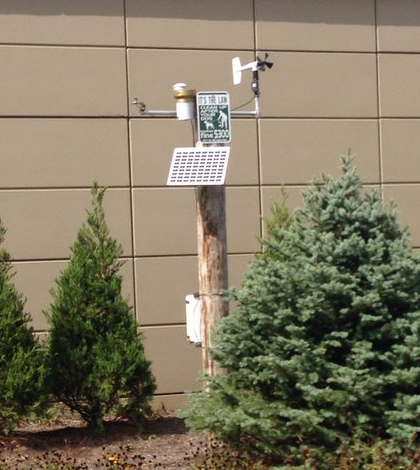Philadelphia: Improving Rain Gardens Through Simulated Tests

Meteorological sensors set up near a green stormwater infrastructure site. (Credit: Villanova University)
Managing stormwater is a concern in cities all across the United States because of its tendency to overflow drains which are linked directly to nearby waterways. This is especially true when the rains come down hard, overloading storm drain systems and sending pollutant-heavy runoff down the line.
Solving the problem isn’t easy, but rain gardens have shown to be particularly useful in reducing the amount of runoff that makes it into drains.
Researchers at Villanova University are testing out the potential of rain gardens in an ongoing partnership with the Philadelphia Water Department. Their efforts are part of the Villanova Urban Stormwater Partnership and are being funded by a U.S. EPA Science To Achieve Results (STAR) grant.
“We are assessing the performance of green stormwater infrastructure sites which have been built in Philadelphia over the past five years as part of the Green City, Clean Waters initiative,” said Cara Albright, doctoral candidate in the department of civil and environmental engineering at the university. “We are looking at these from a volume reduction perspective and using our findings to make recommendations for the next generation of designs.”
Albright says there is instrumentation at four different sites in Philadelphia to record rainfall as well as other meteorological conditions. She and other researchers are also tracking water at the inflows and outflows of each garden in addition to water depth and soil moisture.
The sites were first instrumented beginning in August 2014, Albright says. The most recent one was set up in August of this year.

A scientist works in a rain garden site in Philadelphia. (Credit: Villanova University)
“The study is mostly looking at the volume of stormwater runoff being collected by these sites, and how that can be optimized in the future,” said Albright. “We don’t collect samples or analyze anything for water quality. It is strictly a water quantity study.”
Sites are tested by applying simulated storms and then assessing how each garden does. These simulated runoff tests involve using fire hoses to apply metered hydrant flow to the systems and simulate a storm of a specific duration, volume or intensity.
Albright says the simulations help researchers to verify that their instrumentation is working properly and to judge how the rain gardens are performing. If the installations are underperforming, investigators look to discover design changes that could be made in the future to save money in construction and maximize performance over time.
A considerable amount of data have been gathered so far, even though the project is slated to continue for another year and a half.
“We are trying to learn more about the processes involved in green infrastructure, specifically infiltration and evapotranspiration, and how these processes can be maximized in order to keep the most runoff out of the streets,” said Albright. “The idea is to take runoff from impervious surfaces and direct it up via evapotranspiration or down through infiltration to prevent flooding and combined sewer overflows; this study will be very important for the future of green stormwater infrastructure design in urban areas.”
The collaborative nature of the project also affects how the findings are getting used. And a lot of what comes out of the work is going to help drive changes to Philadelphia’s green stormwater infrastructure design and maintenance.
“There are a lot of challenges with green infrastructure in the urban environment having to do with maintenance of the sites, so we are using the data to inform future maintenance practices as well,” said Albright.
Top image: Meteorological sensors set up near a green stormwater infrastructure site. (Credit: Villanova University)




Pingback: VUSP work in the media – Post 1 | Villanova Urban Stormwater Partnership